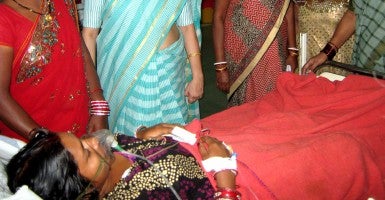Eleven women have died after undergoing laparoscopic tubectomies as part of a mass sterilization campaign in Chhattisgarh, India. Of the more than 80 women who underwent the procedure, 62 have been hospitalized, with many in critical condition.
Unfortunately, this is just the latest in India’s long string of attempts to reduce its population of nearly 1.3 billion.
In the 1970s, under the leadership of then-Prime Minister Indira Gandhi, severe sterilization quotas were instituted to address India’s skyrocketing population. From 1975 to 1977, sterilizations rose from a little over 1 million to more than 8 million.
Although the practice of federal government-mandated quotas has stopped, sterilization quotas continue to be issued by state- and district-level officials in India. Women from Chhattisgarh are the latest guinea pigs in state-led population control efforts. Many women and men have been bribed into sterilization with cars, cell phones and money. Each woman in Chhattisgarh was paid only 600 rupees, or $10, to undergo the procedure.
A single surgeon conducted 83 surgeries in six hours–meaning that the doctor spent only a few minutes sterilizing each woman. After the hasty procedures, women are being treated for septic shock, and the likely cause of death for the other women was infection and loss of blood. The sterilization camp in Chhattisgarh and the doctors who executed the botched procedures are currently under investigation – including one doctor who received an award in 2013 for sterilizing more than 50,000 women.
In addition to sterilization campaigns, the practice of forced abortion and sex-selective abortion that specifically targets baby girls is prevalent in India. The UN estimates tens of millions of girls and women are already lost from India’s population because of sex-selective abortion and population control measures. In fact, in 2011, only 914 girls were born for every 1,000 boys in India. Demographers believe that should this trend continue, at least 10 million more women will have been eliminated from India over the next 15 years.
As Lisa Curtis, a senior research fellow at The Heritage Foundation, noted in the 2011 book “Population Decline and the Remaking of Great Power Politics:”
If the number of Indian women continues to decrease relative to the number of Indian men, this could become a significant source of social instability. The problem manifests itself when marriage rates decline and unmarried men have trouble finding jobs. Observers note that societies with large numbers of single young men are more likely to suffer higher crime rates and more internal unrest and violence than societies in which most men marry and have children.
India’s population control practices, which contribute to sex selection in addition to raising human rights questions, also may jeopardize the health of the economy.
During his speech marking India’s independence day in August, Prime Minister Narenda Modi acknowledged the need for cultural change in how Indian women and girls are viewed within the family and society. Modi deserves credit for addressing the issue in his public remarks, but his government must follow through by instituting and enforcing restrictions on mass sterilizations and sex selection. India should reaffirm the strength and dignity of its women and abandon coercive population control measures for good.





























